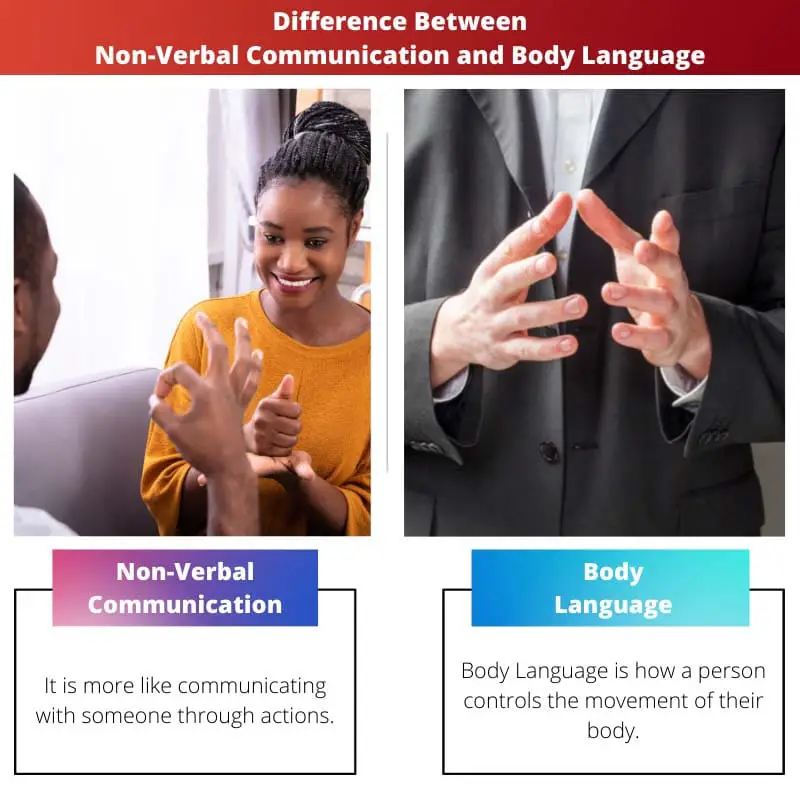Communication skills and body language are the key factors determining someone’s characteristics. Both non-verbal communication and body language sound the same immediately.
Key Takeaways
- Non-verbal communication is any form of communication that doesn’t involve spoken words. At the same time, body language is a specific type of non-verbal communication that involves gestures, postures, and facial expressions.
- Non-verbal communication includes other forms, such as touch, tone of voice, and eye contact, while body language focuses solely on movements and expressions of the body.
- Non-verbal communication is universal, while body language can vary between cultures and individuals.
Non-Verbal Communication vs Body Language
Nonverbal communication means any communication that does not involve the use of words, such as facial expressions, tone of voice, gestures, and eye contact. Body language is a subset of nonverbal communication that specifically use of physical movements, gestures, and posture to convey meaning.

Non-verbal communication signifies the mode of communication with the help of posture and gesture activities. These gestures can also include eye movements, facial expressions, and the space between two people.
Kinesics is the interpretation of the body language of humans in technical terms. It is found in humans as well as animals.
Comparison Table
| Parameters of Comparison | Non-Verbal Communication | Body Language |
|---|---|---|
| Meaning | It is more like communicating with someone through actions. | Body Language is how a person controls the movement of their body. |
| Connotation | Non-Verbal communication refers to the delivery of messages with the help of facial expressions and body postures. | It is simply a feature of the former one, i.e. Non-Verbal Communication. |
| Symbolism | It is used to represent verbal messages differently with the help of expressions and gestures. | Body language is all about intuition. It gives insights into a person’s attitude through how they move their body. |
| Conscious /Unconscious language | It is an unconscious language that delivers the feelings and emotions of a person. | It is a conscious as well as an unconscious language that conveys the attitude of a person. |
| Types | Non-Verbal Communication is of two types: the messages delivered by a person’s body and the letters provided by a broad setting. | Body language is a lot different from sign language. It is a subconscious mode of behaving. On the other hand, sign language is delivered as a total conscious act. |
What is Non-Verbal Communication?
It includes the way we use our time in communicating and conveying messages to others. Various research shows that genetics and phenotypic traits are also a platform for non-verbal communication.
Eye contact and the rate of eye blinking are also a part of the same. When one talks about its origin, non-verbal communication study started in 1872.
People need almost 0.1 seconds to know about another person through their mode of non-verbal communication. As it requires such a short time to give some insights into someone’s attributes, non-verbal communication is nowhere less than verbal communication.

What is Body Language?
Body language is a non-verbal communication that prioritizes physical actions more than words. Kinesics is the interpretation of the body language of humans in technical terms. It is found in humans as well as animals.
For instance, expressing happiness and sorrow are parts of body language that anyone can convey. On the other hand, sign language requires studying a new language system with an algorithm different from others.
One can easily understand from someone’s body language about their attitude and nature towards others. There has been a lot of debate by researchers that whether body language is inherited or not.

Main Differences Between Non-Verbal Communication and Body Language
- Non-Verbal communication is more like communicating with someone through actions, whereas Body Language is how a person controls the movement of their body.
- Non-Verbal communication refers to the delivery of messages with the help of facial expressions and body postures. On the other hand, body language is simply a feature of the former.

- https://books.google.co.in/books?hl=en&lr=&id=KlAPEAAAQBAJ&oi=fnd&pg=PP1&dq=non+verbal+communication&ots=XRgfPqxJD0&sig=J77tjYNIN43AAuZQEDt9aNb0poQ&redir_esc=y#v=onepage&q=non%20verbal%20communication&f=false
- https://books.google.co.in/books?hl=en&lr=&id=yqx1j8ynGfwC&oi=fnd&pg=PA1&dq=Body+language&ots=UgyWGy5s9p&sig=c3ZqTAbI9mJcfLthLbYNi_HuIfo&redir_esc=y#v=onepage&q=Body%20language&f=false

The article is thorough and provides an excellent comparison between non-verbal communication and body language.
I agree, it’s a valuable resource for understanding these concepts.
I think the distinction between conscious and unconscious language could be elaborated further. It’s a crucial point in understanding these topics.
I agree, that’s an important aspect that deserves more attention.
I appreciate the in-depth analysis of non-verbal communication and body language. It really helped clarify their differences.
The explanation of kinesics was particularly enlightening.
I found some sections to be too technical and complicated. The comparison table was hard to follow.
I understand, but I think the technical aspects are essential for a comprehensive understanding.
This article provides valuable information! Understanding non-verbal communication and body language is essential for communication professionals.
Absolutely, it’s crucial for effective communication!
I liked the references section at the end. Great resources for further reading.
The content was informative, but it could benefit from more real-life examples to illustrate key points.
I see your point, real-life examples would make it more engaging.
Very interesting article. It is detailed and gives clear explanations about non-verbal communication and body language.
I agree! The comparison table was really useful.